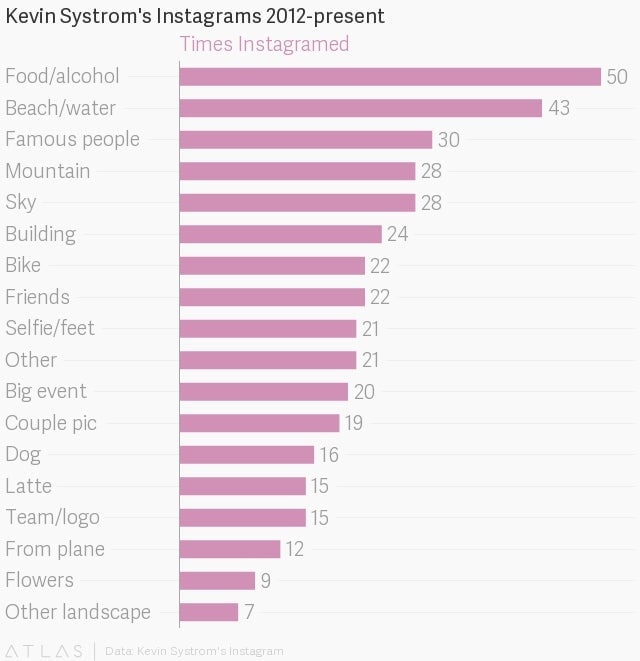Instagram’s CEO is not very good at Instagram—and that’s why he’s good at his job
What does it mean to be “good” at Instagram? Answers vary depending on one’s views of French bulldogs, #vanlife, and Kim Kardashian. But it’s safe to say that a lot of highly-admired and popular accounts possess many of the same traits: a cohesive theme (food, fashion, yoga); a consistent color and saturation palate; unique, well-staged subjects; and attention to composition.


What does it mean to be “good” at Instagram? Answers vary depending on one’s views of French bulldogs, #vanlife, and Kim Kardashian. But it’s safe to say that a lot of highly-admired and popular accounts possess many of the same traits: a cohesive theme (food, fashion, yoga); a consistent color and saturation palate; unique, well-staged subjects; and attention to composition.
But in an age where teens and adults alike aspire to attain “Instafame,” there’s one person who seems perfectly satisfied with Insta-mediocrity: Instagram CEO and co-founder Kevin Systrom.
To be fair, Systrom’s Instagram feed isn’t much worse than most of ours. He’s not bad at Instagram per se; he’s just quite basic. And this trait can actually shed light on what it takes to be a successful startup founder and CEO.
The evidence
Kevin Systrom’s account, much like my own, has yet to zero in on a particular subject. He’s using Instagram the way the plebeians do: just snapping photos of whatever happens to catch his fancy, with sporadic, somewhat half-hearted attempts at personal branding.
This is the subject breakdown of every Instagram Systrom has posted since 2012, when Facebook acquired the company for $1 billion:

Of course, as the head of Instagram who’s tight with the likes of Mark Zuckerberg and Jack Dorsey, Systrom has a lot more famous-people pics than the rest of us. But the other tropes in his photographs are endearingly relatable.
We’re talking about a man who truly loves fairly standard latte art.
A man who is blissfully unaware that airplane-wing shots are a ‘gram cliché.
A man who never met a bike shot he could resist.
There are also various golden retriever pics, primarily of Systrom’s pup, Dolly—who is adorable, we’ve got to admit.
There’s no doubt that Systrom’s Instagrams have improved since 2011-2013, when he regularly posted grainy, poorly-lit photos. And we’re glad he appears to have moved beyond Instagraming his feet from above (so uncreative). He’s still obsessed with photographing his food and drinks from above, but hey, who isn’t. Most of what he posts isn’t terrible—it’s just not good.
Insta-famous opinions
This isn’t just one reporter’s opinion. Chelsea Melone, a former Instagram micro-influencer based in New York City, says the best way to describe Systrom’s Instagram aesthetic is “busy”—primarily because the grid on his main feed features so many different people and objects. ”That’s the word I use to describe a profile that has too much going on,” says Melone. “For my account, I don’t just think about the individual pictures but also how they look together in the grid, because the full-profile is what users see first.”
An ideal grid, says Melone, is clean and easy on the eyes. It’s easier to focus on each individual picture when there’s a variety of subjects, but coherence in terms of filters and colors.

Contrast her grid with Kevin’s, and the differences are immediately apparent.

Liza Herlands, whose New York City-based fashion, food, and travel account has over 36,000 followers, says that Systrom’s profile has “no coherence.” Many of his work photos, like this office shot, look like stock images; they’re high-quality, but they generally do poorly on Instagram. Edited images with a clear focal point and less-saturated filter tend to be more aesthetically pleasing, she says—an effect that Systrom sometimes achieves, as with this bike portrait.
But ultimately, Systrom doesn’t seem to be trying to use his Instagram as a portfolio or to influence others—or heck, even impress them. He’s just using it to document his everyday life and his office job. That’s a decision many might question, given that Systrom is the professional face of Instagram. But there’s actually an upside to his lack of artfulness.
The management lesson
Clearly, Systrom is no photography master. But for founders, a lack of expertise in their company’s core offering can actually come in handy.
“Systrom’s rise is the opposite storyline to the one we hear so often—of founders who are such deep product people that they’re really only suited to the first phase and don’t have the leadership it takes to shepherd the company through continued growth,” says Liane Davey, an organizational psychology expert and author of You First: Inspire Your Team to Grow Up, Get Along, and Get Stuff Done.
Unlike many developers, who build incredible apps but cannot secure funding, lead a team, or manage growth, Systrom, a fan of academic business theories, is well-suited to his role as CEO, says Davey. As this New York Times feature explains, Systrom focuses on decision-making strategies that efficiently dismantle bottlenecks to customer satisfaction, and, in turn, facilitate rapid growth. He believes Instagram’s mission is “to make sure that everyone can capture and share the world’s moments, and use them to form stronger relationships with one another”—not to promote beautiful photographs, necessarily. This distinction facilitates both his critical distance from the product, and his flexibility regarding its innovations.
In fact, Thomas Eisenmann, a professor of business administration and entrepreneurship at Harvard Business School, says that a number of successful startup founders—including the people behind Warby Parker, Casper, Blue Apron, BirchBox, and Rent the Runway—knew little about their products’ industries before founding their now-profitable businesses. “Sometimes long tenure in an industry can blind individuals to create new approaches,” he says.
Ultimately, the most important trait in a founder and CEO is an ability to understand what customers want. In this respect, Systrom shines, while many founders fall victim to what Nick Tasler, an organizational psychologist and author of The Impulse Factor: An Innovative Approach to Decision Making, calls the “curse of knowledge.”
Employees who are total geeks about their product often struggle to truly relate to and understand how the vast majority of users actually want to use it, says Tasler. Systrom’s impressively average Instagram demonstrates his immunity to this curse. Cutting-edge as the Instafamous may seem, they are but a tiny fraction of Instagram’s user base. It’s the normal, latte-loving, selfie-taking masses—people a lot like Systrom—who determine the company’s success.